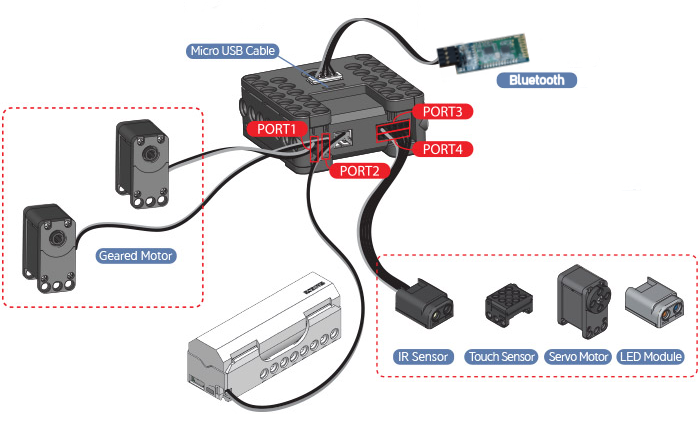
STEAM is an educational approach to learning that uses science, technology, engineering, the arts and mathematics to foster inquiry, dialogue, and critical thinking.
Your Edbot Dream is a STEAM-oriented robotics system which enables you to build 20+ different robots and code them with Scratch 2.0, Scratch 3.0, Python, Java, JavaScript, Node.js and many other languages with multi-user networking support.
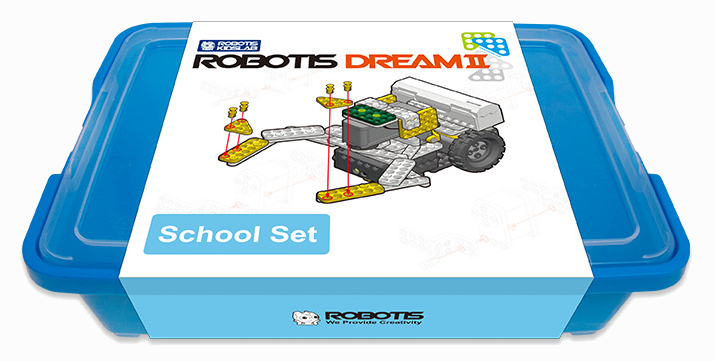
|
Before starting please read the safety precautions. |
The Edbot Dream box has been designed to keep the various components together. The key parts are described below. See the parts list at the end of this guide for a complete list.
CM-150 microcontroller.
SM-10 servo motor.
2 x GM-10 geared motors.
Bluetooth module with cable.
Packets of rivets and a round plastic case to store them.
Rivet extraction tool.
Plastic plates, wheels etc. for assembly.
LB-041 rechargeable Li-ion battery.
LBB-041 battery cradle.
Micro USB to USB charging cable that connects the battery cradle to a USB charger (not included).
RC-100 remote control unit - not used by the Edbot Software.
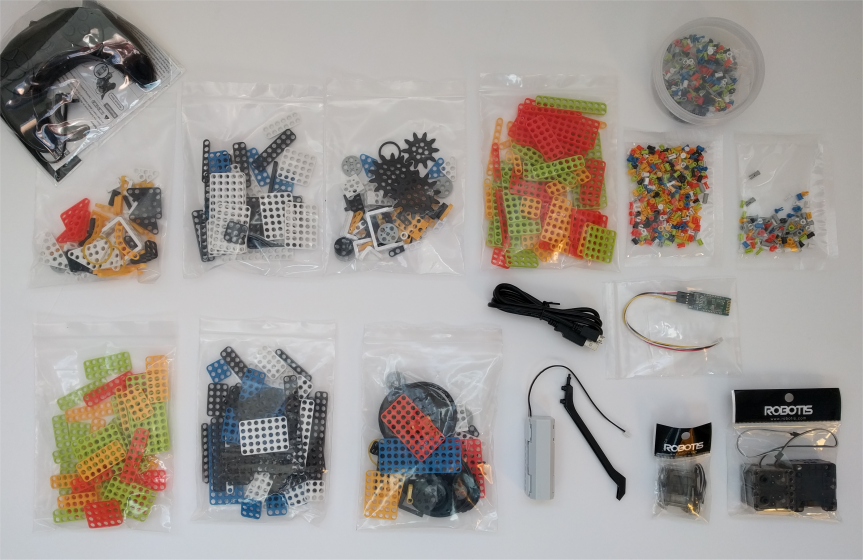
Charge the battery. Your battery will initially contain a small amount of charge for testing and may not have enough power to supply the microcontroller and Bluetooth module. See the charging section for details.
Remove the CM-150 microcontroller from its packaging (it is packed along with the two geared motors). This microcontroller has a built-in buzzer, noise detector and three infrared distance sensors. It has four ports for connecting external equipment. The geared motors connect to ports 1 & 2. Ports 3 & 4 are multi-purpose 5-pin ports for connecting the servo motor and various other sensors and modules (supplied separately).

To switch on the microcontroller first connect the battery, then hold the start button down for a second until it beeps twice. Release the start button. Press the start button again to switch off the microcontroller.
|
It is very important to press and hold the start button until the microcontroller beeps twice. This places it in command mode and enables it to communicate with the Edbot Software. |
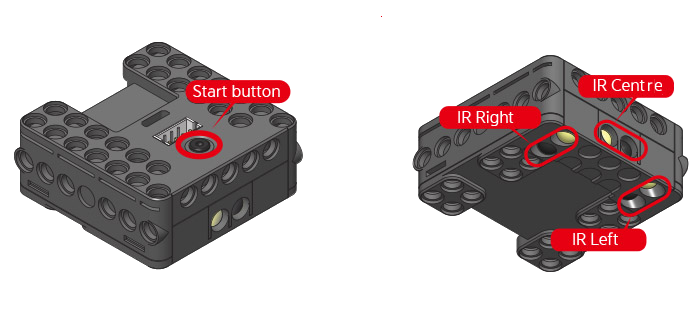
Your Edbot Dream is supplied with two motors (GM-10) and a servo motor (SM-10). Connect motors to port 1 / port 2 of the microcontroller using a 2-wire cable. You can control the motor speed and direction. The servo motor connects to port 3 / port 4 using a 5-wire cable. It can operate in wheel mode when it acts just like a motor. It can also operate in joint mode when you can set it to a specific position and read it's current position.
Connect the Bluetooth module to the microcontroller using the supplied cable as shown below. Be careful to connect the cable the right way round. You may find the plug needs a firm push home.
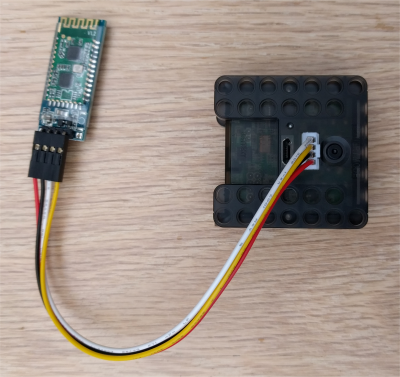
Empty the rivets into the round plastic storage case. The rivets are used to fasten the various components together. You'll need to assemble each rivet before use by clicking the pin into the rivet base.

It is very important to ensure the pin is inserted into the rivet in the correct orientation such that the lugs on the end of the pin are aligned with the slots in the rivet and the pin can freely slide inside the rivet with ease. Failure to align the pins correctly could mean they break or become loose and fall out when the Edbot Dream is in operation. |
When inserting a rivet, make sure the pin is not pushed into the rivet before use. Use the supplied rivet extraction tool to remove a rivet.
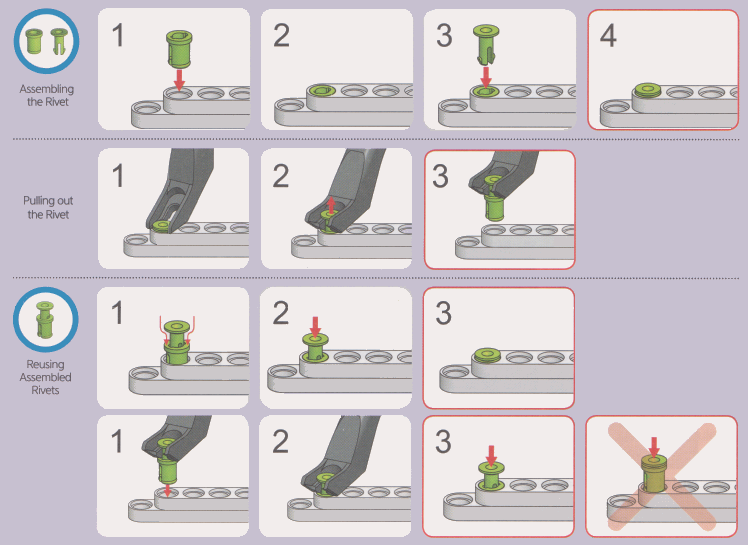
The battery has the following properties:
Type: Lithium-ion (Li-ion)
Weight: 50g
Dimensions: 24 x 70 x 27mm
Voltage: 3.7V
Capacity: 1300mAh
A protection circuit module (PCM) is incorporated to protect the battery from overcharge, discharge and excessive current.
The battery is charged in situ. The batteries will be automatically disconnected from your Edbot Dream whilst they are being charged.
Connect the charging cable to the cradle by fitting the micro USB plug into the corresponding socket on the battery cradle. |
|
Connect the plug on the other end of the charging cable to a USB charger (not supplied). |
|
Battery charging is indicated by a steady red light on the charging LED. The LED will extinguish when the battery is fully charged. |
|
We recommend using a USB charger that can deliver at least 1.3A at 5V to give a charging time between 2 and 3 hours.
Download and set up the Edbot Software. You'll find the product key printed on a label attached to the outside of the Edbot Dream box.
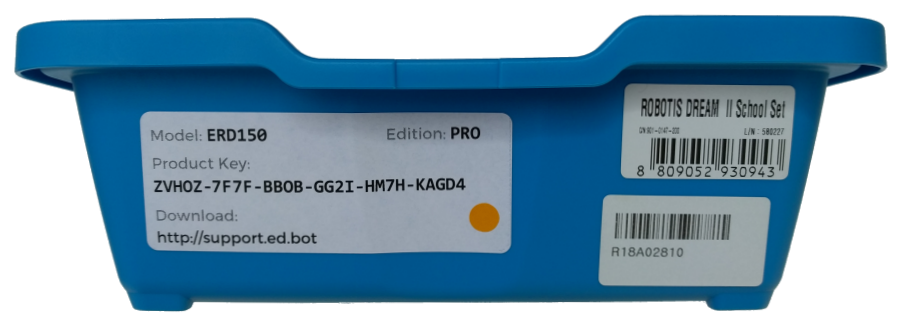
|
Once activated, your product key will be permanently associated with its Bluetooth module. If you have purchased multiple Edbot Dream kits it is a good idea to use colour-coded stickers to link the two together. Place a coloured sticker on the product key label and affix the same coloured sticker to the Bluetooth module. Repeat this for each of your Dream kits using a different colour for each kit. |
Battery not charging.
If the battery is not fully charged and the charger LED does not display a red charging light:
Inspect the battery, battery cradle and cable for damage. If damaged do not use and contact us for a replacement.
Check the battery is fitted correctly in the cradle, lining up the metal connectors on the battery and the battery cradle contacts.
Check the charging cable is fitted correctly.
Check the USB power adapter is turned on.
Edbot Dream not connecting to the Edbot Software via Bluetooth.
Check the Edbot Software is running and Bluetooth connectivity is turned on.
Make sure the battery is charged. See Charging.
Check your Edbot Dream is switched on correctly. Hold down the start button until the microcontroller beeps twice.
Check the Bluetooth module LED is flashing and your Edbot Dream is not connected to another device.
Check your Edbot Dream is within the Bluetooth transmission range of 10 metres.
|
Note it can take up to 15 seconds for your Edbot Dream to connect via Bluetooth. |
Read the following safety information carefully and get familiar with the controls and proper use of your Edbot Dream. Following these safety precautions will keep you, your students and your Edbot Dream safe.
Only use your Edbot Dream for the purpose for which it was designed, ie. teaching programming skills through robotics. Any other use can be hazardous and may damage your Edbot Dream.
|
Do not attempt repairs
Do not attempt to take apart, open, service, or modify the product or accessories. Doing so could present the risk of electric shock or other hazard. Any evidence of any attempt to open and/or modify this device, including any peeling, puncturing or removal of any labels will void the Limited Warranty. Heed all warnings and follow all instructions. |
|
Choking hazard
This device contains small parts and is not suitable for children under 3 years of age. Keep small parts away from children. |
|
Small children
This device and its accessories are not toys. Do not allow small children to play with them because they could hurt themselves or others or damage the device. Keep the device and all its parts and accessories out of the reach of small children. Not suitable for children under 8 years of age. Adult supervision required. |
|
Use near water
To reduce the risk of fire or shock, do not use this device near water and do not expose it to rain or moisture. Do not attempt to dry the device with a hair dryer or a microwave oven. |
|
Potentially explosive atmospheres
Areas with potentially explosive atmospheres are often, but not always, posted and can include fuelling areas, below deck on boats, fuel or chemical transfer storage facilities or areas where the air contains chemicals or particles, such as grain dust or metal powders. Do not switch on or use the device in such an area. |
|
Interference problems
Turn off your device in any location where posted notices instruct you to do so. In an aircraft, turn off your device whenever instructed to do so by airline staff, or prior to packing a wireless device in luggage. Please consult airline staff about using the device in flight. |
|
Avoid skin irritation
This device is made of materials commonly used in worn consumer electronic devices. However certain people may develop irritation due to allergies or sensitivities. If your skin becomes irritated, stop using the device. If symptoms are severe or persist, consult your doctor. |
|
Cable and cord safety
Arrange all cables and cords so that people and pets are not likely to trip over or accidentally pull on them as they move around or walk through the area. Do not allow children to play with cables and cords. Protect cables from being pinched or sharply bent. Do not jerk, knot, sharply bend, or otherwise abuse the cables. Do not expose the cables to sources of heat. Keep children and pets away from the cables: do not allow them to bite or chew on them. If a cable becomes damaged in any way, stop using it immediately. |
|
Parts of this device are magnetic
It may attract metallic materials. To reduce the potential risk of sparks, verify the electrical connection area is free of metallic objects before connecting devices. In order to reduce the likelihood of magnetic fields interfering with compass readings, disrupting the proper operation of pacemakers, or corrupting magnetically stored data, do not place credit cards or other magnetic storage media or magnetically sensitive devices near this device. |
|
People with photosensitive epilepsy
The device contains flashing lights that could trigger a seizure in people with photosensitive epilepsy. |
|
People with pacemakers
The device contains a Bluetooth module which is a wireless transmitter. The Health Industry Manufacturers Association in the US recommends that a minimum separation of 15cm be maintained between a wireless device and a pacemaker to avoid potential interference with the pacemaker. If you have an reason to suspect that interference is taking place, turn off the device immediately. |
|
Other medical devices
If you use any other personal medical device, consult the medical device manufacturer or your physician to determine if it is appropriate for you to use this device near your personal medical device. |
Only used the supplied battery in your Edbot Dream.
Never use your Edbot Dream in direct sunlight or near a heat source. Excessive heat can damage the servo motors.
Never use your Edbot Dream near water. Your Edbot Dream is not waterproof.
Never use excessive force to move your Edbot Dream's joints or limbs, this may damage the servo motors.
Never use sharp or pointed objects with your Edbot Dream.
|
During motions your Edbot Dream may move quickly and will not detect obstructions. Adult supervision is required. |
Do not store your Edbot Dream in direct sunlight or near a heat source. Excessive heat can damage it.
Only use the battery in your Edbot Dream. Do not use the battery in any other device. If the battery is used in other devices it may damage the performance of the battery or reduce its life expectancy. If the device causes an abnormal current flow, it may cause the battery to become hot, explode, or ignite and cause serious injury.
The temperature range over which the battery can be used is -10°C to 60°C. Do not use the battery outside this temperature range.
Do not pierce the battery with nails, strike it with a hammer or otherwise subject it to strong impact or shock.
Do not expose the battery to water or allow the battery to get wet.
Do not disassemble or modify the battery. The battery contains safety and protection devices which, if damaged, may cause it to generate heat, explode or ignite.
Do not use the battery on or near fire, direct sunshine or other high-temperature locations.
Immediately discontinue use of the battery if, while using, the battery emits an unusual smell, feels hot, changes colour, changes shape, or appears abnormal in any other way. Contact Robots in Schools Ltd if any of these problems are observed.
Follow the precautions for using the battery detailed in the section above and additionally:
Only use the supplied charger cradle to charger you Edbot Dream battery.
The temperature range over which the battery an be charged is 0°C to 45°C. Do not charge the battery outside this temperature range.
Store the battery in the battery cradle.
If you are not planning to use the battery for 6 months or longer, first charge it fully and then recharge it once a year. A Li-ion battery that has been left discharged for too long may no longer effectively hold charge.
Do not dispose of the battery in household waste. Instead, it is your responsibility to hand it over to an applicable collection point for the recycling of batteries.

| Term | Definition |
|---|---|
Bluetooth |
Bluetooth is a way of exchanging data wirelessly over short distances using radio transmissions. |
Li-ion Battery |
A type of rechargeable battery which has twice the energy capacity of a Nickel-Cadmium battery and greater stability and safety. |
Robot Microcontroller |
A robot microcontroller is an entire computer integrated into a single chip which includes a processor, memory, a communications interface and programmable input and output pins to read sensors and control servo motors. It is often referred to as the 'brain' of a robot. |
Programmable Robot |
A programmable robot can be instructed to perform a sequence of steps in a repetitive manner. It can then be reprogrammed to perform a different sequence of steps. |
Python |
Python is an interpreted, cross-platform, object-oriented programming language created by Guido van Rossum in 1991. It supports modules and packages, which encourages program modularity and code reuse and its simple, easy to learn syntax emphasises readability. |
Scratch |
Scratch is a visual programming language developed by the MIT Media Lab. It can be used for a range of educational purposes from maths and science projects to animated stories with art and music. It provides a stepping stone to the more advanced world of computer programming. |
A servo motor is an actuator that allows for precise control of angular position, velocity and acceleration. It consists of a motor coupled to a sensor for position feedback and requires a relatively sophisticated controller. |
Your Edbot Dream is covered by a one-year limited warranty including parts and labour, subject to the conditions listed below.
The conditions of the warranty:
This warranty applies to defects or faults notified to Robots in Schools Ltd within one year from the date of purchase of the equipment.
This warranty covers use of your Edbot Dream for the purpose for which it was designed ie. an educational robot for teaching programming skills. Robots in Schools Ltd declines any liability for damages caused by improper use.
This warranty does not cover any faults or defects caused by failing to follow the safety information provided in this owner's manual, or any attempt to repair, modify or adjust your Edbot Dream.
This warranty is offered as an additional benefit to your statutory rights and does not affect these rights in any way.
In the unlikely event of your equipment requiring repair, please contact Robots in Schools Ltd. You will need to provide proof of date of purchase, so please keep your invoice or receipt which is supplied at the time of purchase.
No liability can be accepted for any inaccuracies or omissions in this publication, although every possible care has been taken to make it as complete and accurate as possible.
The product has undergone testing and complies with the following standards.

